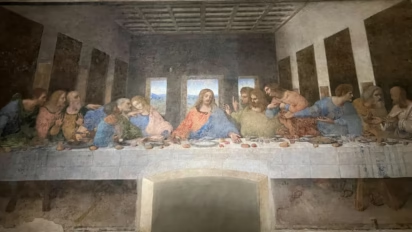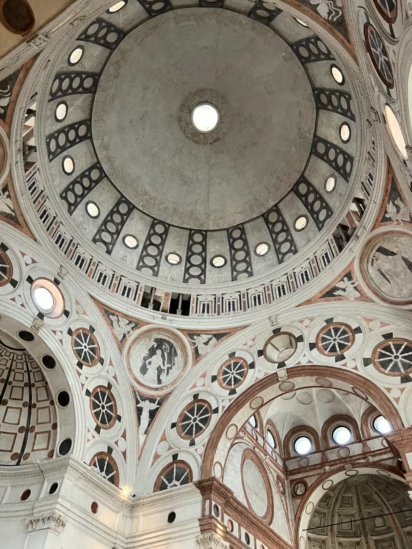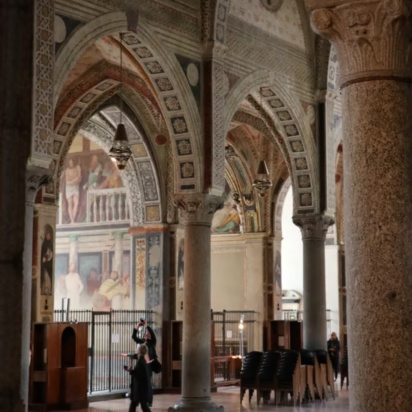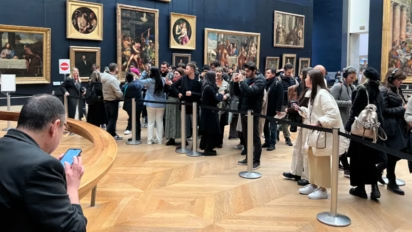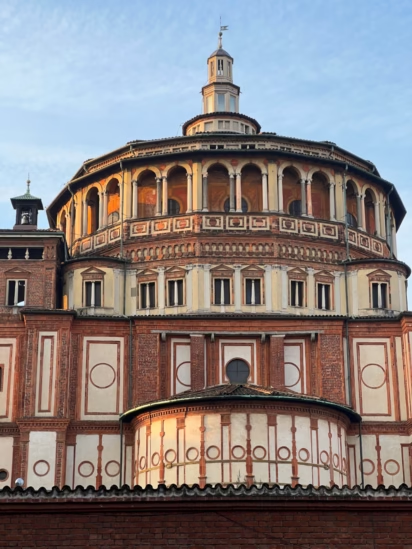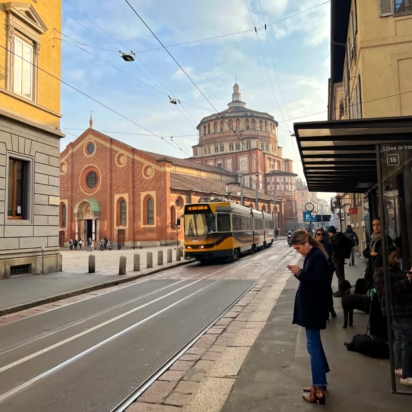The Santa Maria delle Grazie church in Milan may be seen freely without tickets but to visit The Last Supper painted on the convent’s refectory wall by Leonardo da Vinci requires time-slot reservations.

The Chiesa di Santa Maria delle Grazie (Holy Mary of Grace Church) in Milan is mostly famous for The Last Supper which Leonardo da Vinci painted on the wall of the refectory of the local Dominican convent. While tickets for The Last Supper Museum are essential, the large church may be seen for free and without tickets. Opening hours for tourist visits are limited but even the exterior of the mostly Gothic and Renaissance building is worth seeing. Guided tours of Santa Maria delle Grazie are sometimes combined with visits to The Last Supper.
Chiesa di Santa Maria delle Grazie in Milano

The current Chiesa di Santa Maria delle Grazie (Holy Mary of Grace Church) in Milan dates mostly from the late 15th and early 16th centuries. The triple naves and side chapels are mostly Gothic while the apse, choir, and much of the impressive exterior are early Renaissance.
The Santa Maria dell Grazie church was built in the late 15th century as part of a new Dominican convent on the outskirts of Milan. The monastery buildings (mostly destroyed during the Second World War) and the new Gothic hall church were designed by Guiniforte Solari, the leading Milanese architect of the period.
The church was typical for Lombardy: a triple-nave hall church with Gothic vaulting and 13 side chapels. The naves emphasize width rather than height. Local terracotta bricks were used for the walls and granite stones for the columns. The Gothic church was completed between 1463 and 1482.
The western facade is rather plain as was the original intention. The triangular gable is far higher than the roof of the hall church, with the roof of the nave far higher than needed, as the vaulting of the three aisles is of equal height. Baroque detailing was removed during the 19th century, except for the 15th-century marble portal donated by Duke Ludovico Sforza.
Duke Ludovico il Moro Sforza
It was the intervention of Duke Ludovico il Moro (1452-1508) that made Santa Maria delle Grazie famous and a top tourist sight (and a UNESCO World Cultural Heritage listed site). Ludovico employed Leonardo da Vinci to amongst others paint The Last Supper on the wall of the refectory of the convent. (The Last Supper Museum in the refectory is seen separately from the church — advance time-slot reservation tickets are essential and hard to buy without booking a guided tour.)
Although famous and highly regarded from the start, Da Vinci’s The Last Supper was not the main project of Duke Ludovico at Santa Maria delle Grazie. He intended to create a Sforza family mausoleum in the church. He thus sponsored a new Renaissance apse and monumental tribune impressive enough to confirm the importance and power of the Sforzas.
However, fate interfered. His wife, Beatrice d’Este, died aged 22 in childbirth and was buried in the new Renaissance choir in 1497. Only a few years later, in 1499, Ludovico fell from power and eventually died as a prisoner in France. His remains were never expatriated and after the Sforza family became extinct in 1535, all major construction work was suspended. Beatrice’s grave monument was eventually dispersed.
Renaissance Santa Maria delle Grazie
The monumental Renaissance apse and tribune of Santa Maria delle Grazie are the dominant architectural features that make the church such an impressive sight. It was built to impress and still towers over all buildings in the area.
The design is usually attributed to Donato Bramante. He brought the Renaissance to Milan and more famously the High Renaissance to Rome when he drafted the basis of St Peters in the Vatican (before Michelangelo and Bernini took over). Brunelleschi’s Old Sacristy in San Lorenzo in Florence clearly influenced his work on Santa Maria delle Grazie
The tribune is particularly impressive: the dome rests on a low drum placed on a cube of monumental proportions. Inside, the four arches of the cube give access to the two semicircular apses, the nave, and the choir. The light and dark decorations emphasize the circular motifs of the overall design.
Outside, the tribune and apses are richly decorated with numerous shields, reliefs, and detailing. The red brick is offset by lighter stone or plastered sections. A pillared gallery runs along the top of the drum just below the external dome, which is in the form of a sixteen-sided prism.
Interior of Santa Maria delle Grazie

The interior of Santa Maria dell Grazie is not so overwhelmingly impressive or rich in art as for example the Duomo or the nearby free San Maurizo (“Sistine Chapel of Milan”) but it is still well worth seeing.
Many of the frescoes and painted decorations are original. These were overpainted several times and only rediscovered in the early 20th century. The damage caused by the air raid and fire in 1943 is still easily seen on the northern (left) apse and chapels.
The 13 chapters are filled with art with works well identified in both Italian and English. (A fairly detailed description in English is available from Humana Lens.) The frescoes by Gaudenzio Ferrari in the Chapel of the Holy Crown are particularly highly valued.
Guided tours in English are fairly rare although the church is sometimes included in guided tours of The Last Supper.
The large stucco relief on the lunette above the chapel of the Virgin of Graces dates from 1632 and shows the Coronation of the Virgin between Saints Catherine and Dominic. The chapel itself predates the church and is usually reserved for prayer.
The two most famous works ever displayed in the church were taken by Napoleon to France and never returned:
- Titian’s Crowning with Thorns now hangs in the Louvre in the same hall as the Mona Lisa, while
- Saint Paul in Meditation by Gaudenzio Ferrari is in the Musée des Beaux Artes in Lyon.
(Apparently, the Austrians who governed Milan at the time, failed to demand the return of both paintings!)
Cloisters and Sacristy
Much of the convent complex was destroyed in an air raid in 1943 — sandbags saved The Last Supper while friars managed to put out fires in the small cloisters of the frogs (Chiostro delle rane). The lovely small cloisters, named after the four frogs on the central fountain, are accessible from the front of the church or directly from Via Caradosso.
The cloisters house a small souvenir shop but also the entrance to the Bramante-designed sacristy. The old sacristy (Sacrestia Vecchia) is usually only open on weekend afternoons but is well worth seeing — some of the frescoes might be by Leonardo. The cupboard doors with biblical scenes and the wall frescoes are from the early 16th century.
Opening Hours to Visit Santa Maria delle Grazie in Milan
The opening hours to visit Santa Maria delle Grazie in Milan are much shorter than for The Last Supper Museum in the refectory.
See Visit the Last Supper Museum in Milan: When, Where, How, What to Expect? on the process on the day of visiting to see The Last Supper. A visit to the museum is completely independent from a visit to the church.
For tourist visits, the basilica and cloister are open Monday to Saturday from 9:00 to 12:20 and 15:00 to 17:50, and on Sundays only from 15:00 to 17:50. The Bramante Sacristy (off the cloisters) is usually open on weekend afternoons only.
Outside the tourist hours, it might be possible to have a quick and discrete visit between masses. The church itself is open Monday to Saturday from 7:00 to 13:00 and 15:00 to 19:30 and on Sunday from 7:30 to 12:30 and 15:00 to 21:00.
Admission to the church and cloisters is free.
Transportation to Visit Santa Maria delle Grazie in Milan
Getting to Santa Maria delle Grazie in Milano is easy from most parts of the city. The closest metro stations are Cadorno (Line 1 red or Line 2 green) and Conciliazione (red). Tram 16 (from near the Duomo) stops right in front of the piazza. It is also a simple walk to church from the Duomo area or the Sforza castle.
Other interesting sights near Santa Maria delle Grazie include The Last Supper Museum, the free church of San Maurizio (“Sistine Chapel of Milan”), and the wonderful, large, family-friendly Leonardo da Vinci National Museum of Science and Technology with several models of his designs and a wealth of information and exhibitions on all aspects of technology and several historical vehicles and vessels. The Sforza castle is also just a few blocks away.
More Tips on Milan Sights and Tickets
- Top Leonardo da Vinci Sights and Art to See in Milan
- The Last Supper by Leonardo Da Vinci:
- How to Buy Tickets for the Last Supper,
- What to Expect when Visiting the Last Supper Museum,
- Tips on How to Buy Tickets or Book Tours for the Last Supper Museum — buy early or only guided tours are available,
- How to Get Free Tickets for The Last Supper and a step-by-step guide for booking free Sunday tickets,
- Booking Guided Tours of The Last Supper at GYG.
- Visit Chiesa di Santa Maria Delle Grazie — admission to the church next to The Last Supper Museum is free.
- Visit the Free San Maurizio Church — endless Renaissance frescoes in the “Sistine Chapel of Milan”
- Visit the Pinacoteca Ambrosiana to See Leonardo Da Vinci’s Musician Painting and the Codex Atlanticus.
- Visit the National Museum of Science and Technology Leonardo da Vinci
- Milan Duomo Complex:
- Cheapest Public Transportation to Milan Malpensa Airport (MXP).
- Book luggage storage in advance — close to transportation hubs is generally the better option.
- Book Last Supper Tours at Viator.
- Book Guided Tours for the Duomo, Last Supper, and other sights in Milano from Get Your Guide.
- Buy Admission Tickets for the Duomo and top sights in Milan from Tiqets.
- Buy Milan Guidebooks at Amazon.
